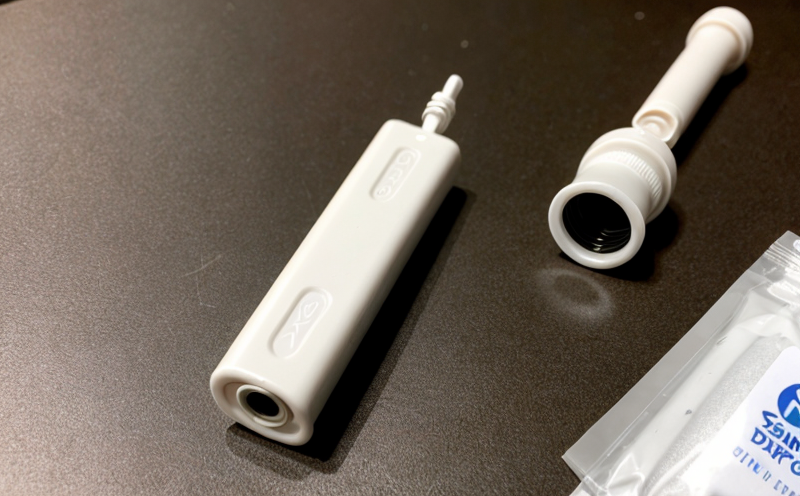ISO 10993-5 Cytotoxicity Testing of Disposable Device Materials
The ISO 10993 series is a set of standards that provides guidance on biocompatibility testing for medical devices. Among these, ISO 10993-5 focuses specifically on cytotoxicity testing, which evaluates the potential of materials and articles to cause cell damage or death when in contact with biological tissue.
This test is critical for ensuring that disposable and single-use devices do not pose a risk to patients. The test involves exposing cells to extracts or leachates from the device material under standardized conditions. Following exposure, the cytotoxicity of the extract is assessed by evaluating the viability of the exposed cells using methods such as cell counting, lactate dehydrogenase (LDH) release assays, and trypan blue exclusion.
Materials commonly tested include plastics, rubber, metals, ceramics, and composites used in disposable medical devices. These materials may come into contact with blood, tissue, or other bodily fluids during use. The results of the ISO 10993-5 test are crucial for regulatory compliance and product safety.
The testing process typically involves several steps:
- Preparation of the device material to generate extracts or leachates
- Exposure of cell cultures to these extracts
- Assessment of cellular viability using various methods
The results are evaluated based on predefined criteria, ensuring that any potential cytotoxic effects can be identified and addressed. Compliance with this standard is essential for obtaining regulatory approvals and ensuring patient safety.
Cytotoxicity testing plays a vital role in the development of new medical devices. By identifying and mitigating risks early in the design process, manufacturers can ensure that their products meet high standards of safety and efficacy. This is particularly important for single-use devices where repeated use would increase the risk to patients.
Our laboratory provides comprehensive ISO 10993-5 cytotoxicity testing services tailored to the needs of medical device manufacturers. Our team of experts ensures that all tests are conducted in strict adherence to international standards, providing accurate and reliable results.
Applied Standards
The ISO 10993 series of standards is widely recognized for its comprehensive approach to biocompatibility testing of medical devices. Specifically, ISO 10993-5 focuses on cytotoxicity testing using the in vitro method based on the principle that substances with potential toxicity should not cause a significant decrease in cell viability.
The standard specifies detailed procedures for preparing extracts or leachates from device materials and exposing them to cell cultures. The cells used are typically Vero cells, which are widely accepted as suitable indicators of cytotoxicity. After exposure, the cells are evaluated using various methods such as:
- Lactate dehydrogenase (LDH) release assays
- Trypan blue exclusion tests
- Microscopic observation for cell morphology changes
The acceptance criteria are based on predefined thresholds that indicate whether the tested material is cytotoxic. Any extract or leachate that causes a significant decrease in cell viability may be deemed unsuitable for use in medical devices.
Our laboratory adheres strictly to these standards, ensuring that all tests are conducted with precision and accuracy. This ensures that the results are reliable and can be used as part of the regulatory approval process.
Why Choose This Test
Cytotoxicity testing is a fundamental aspect of medical device development and compliance. It helps manufacturers ensure that their products meet stringent safety standards, thereby protecting patients from potential harm. Here are several reasons why choosing this test is crucial:
- Regulatory Compliance: Regulatory bodies worldwide, such as the FDA and EU-MDR, require cytotoxicity testing for medical devices to ensure safety.
- Patient Safety: By identifying potentially harmful materials early in the development process, manufacturers can eliminate risks before products reach the market.
- Quality Assurance: Consistent results from cytotoxicity tests help maintain high-quality standards across production batches.
- Competitive Advantage: Demonstrating compliance with international standards enhances a company’s reputation and competitive position in the medical device industry.
- Risk Mitigation: Early identification of problematic materials can prevent costly recalls and legal issues.
In summary, cytotoxicity testing is an essential step in the development and validation of safe medical devices. Our laboratory offers expert services to ensure that your products meet these critical standards.
Quality and Reliability Assurance
The ISO 10993-5 test is part of a broader framework for ensuring the biocompatibility of medical devices, which includes various other tests such as pyrogen testing, irritation testing, and allergenicity testing. Quality assurance in this context involves not only conducting these tests accurately but also maintaining meticulous documentation and traceability throughout the process.
At our laboratory, we employ advanced instrumentation and techniques to ensure that every test is conducted under controlled conditions. This includes:
- Use of high-quality cell culture media
- Precision in preparing extracts or leachates
- Standardized exposure times and temperatures
- Regular calibration of testing equipment
We also maintain strict quality control measures to ensure that all results are consistent and reliable. This includes:
- Detailed documentation of each test run
- Comparison with previous test results for consistency
- Use of reference materials where appropriate
In addition to the technical aspects, our team of experts ensures that all tests are conducted in compliance with international standards. This approach not only enhances the reliability of the results but also provides peace of mind for manufacturers who rely on these tests.





